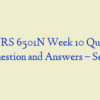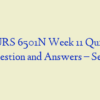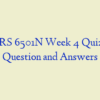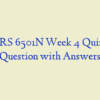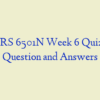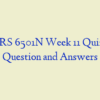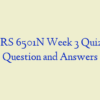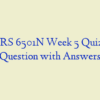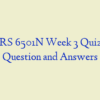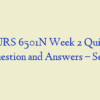Description
NURS 6501N Week 4 Quiz – Question and Answers
- A 54-year-old male is diagnosed with left bundle branch block. Which of the following structures would not receive an electrical impulse?
- Most cases of combined systolic and diastolic hypertension have no known cause and are documented on the chart as _____ hypertension.
- A 62-year-old male presents to his primary care provider reporting chest pain at rest and with exertion. He does not have a history of coronary artery disease and reports that the pain often occurs at night. He is most likely experiencing which type of angina?
- A 32-year-old female presents with lower leg pain, with swelling and redness. While obtaining the patient’s history, which finding could have caused her condition?
- A 5-year-old female is found to have hypertension during three separate visits to her primary care provider. The nurse would expect tests to suggest that the hypertension is secondary to:
- A 60-year-old male is diagnosed with cerebral aneurysm. Where does the nurse suspect the cerebral aneurysm is located?
- A 50-year-old male with a 30-year history of smoking was diagnosed with bronchogenic cancer. He developed edema and venous distention in the upper extremities and face. Which of the following diagnosis will the nurse observe on the chart?
- A 35-year-old male presents with pulmonary hypertension. Testing reveals he is in right heart failure. Which of the following is the most likely diagnosis the nurse will see listed on the chart?
- A 60-year-old male undergoes surgery for a bone fracture.
- Which of the following nursing measures would be most effective for preventing pulmonary embolism (PE) in this patient?
- A 50-year-old obese male with hypertension and coronary artery disease visits a nutritionist for food counseling. He has an elevated level of low-density lipoprotein (LDL) and a low level of high-density lipoprotein (HDL). Which of the following should the nurse advise him to avoid?
- A 65-year-old male presents for a routine checkup. A blood pressure check reveals a systolic pressure of 160 mm Hg and a diastolic pressure of 70 mm Hg. Which of the following is the most likely cause of this type of pressure elevation?
- An 82-year-old female was admitted to the hospital with confusion and severe hypotension. Her body’s compensatory mechanisms are increased heart rate, vasoconstriction, and movement of large volumes of interstitial fluid to the vascular compartment. What kind of shock does the nurse suspect the patient is experiencing?
- A 65-year-old male is transported to the ER for chest pain. An electrocardiogram reveals a prolonged QRS interval. What is the nurse monitoring when the nurse observes the QRS complex on the electrocardiogram? The QRS complex reflects:
- A 50-year-old male is diagnosed with pulmonary embolism (PE). Which of the following symptoms most likely occurred before treatment?
- A 70-year-old female is in the hospital for pelvic fracture. She develops pulmonary thromboembolism. The nurse realizes this embolus is composed of:
- A 50-year-old male visits the cardiologist for an EKG. Results indicate that he has no PR interval and a variable QRS rate with rhythm irregularity. Which of the following is the most likely diagnosis to be recorded on the chart?
- Many valvular stenosis and regurgitation disorders in adults have a common etiology.
- Which of the following conditions should alert the nurse that the patient may have both types of valve dysfunction?
- A 30-year-old Caucasian female was recently diagnosed with primary hypertension. She reports that she eats fairly well, usually having red meat and potatoes daily. She also reports that her father has hypertension as well. A nurse determines which of the following risk factors is most likely associated with this diagnosis? nurs 6501n week 4
- When a patient has a massive pulmonary embolism (PE), what complications will the nurse monitor for?
- A 50-year-old female received trauma to the chest that caused severe impairment of the primary pacemaker cells of the heart. Which of the following areas received the greatest damage?
- While planning care for a patient with superior vena cava syndrome (SVCS), which principle should the nurse remember? SVCS is a progressive _____ of the superior vena cava (SVC) that leads to venous distention of the upper extremities and head.
- A 65-year-old female presents to the emergency department reporting difficulty swallowing and shortness of breath. A CT scan would most likely reveal an aneurysm in the:
- A nurse monitors the patient for _____ when rapid onset of malignant hypertension results. nurs 6501n week 4
- A 68-year-old female is experiencing left heart failure. Physical exam reveals elevated blood pressure. The nurse understands this is most likely caused by: (nurs 6501n week 4)
- An 80-year-old female is in the hospital for a bone fracture. While there she develops a large, nonlethal pulmonary embolus. Which of the following is a direct result of the obstruction to pulmonary blood flow?
- A 50-year-old female presents with a low heart rate and low blood pressure. She is given an intravenous (IV) infusion of fluids. The increase in atrial distension results in:
- A 59-year-old female is diagnosed with left ventricular failure. If a decrease in kidney perfusion occurs, the nurse knows this would ultimately cause:
- A 56-year-old male is diagnosed with coronary artery disease. Which of the following modifiable risk factors would the nurse suggest the patient change? (nurs 6501n week 4)
- A patient wants to know what causes atherosclerosis. How should the nurse respond? In general, atherosclerosis is caused by:
- Which organ should the nurse monitor closely since it is often the first to fail in patients with multiple organ dysfunction syndrome (MODS)?
- So, check out our latest Tutorials and Courses on BUSI 435.


